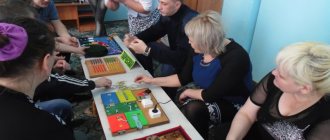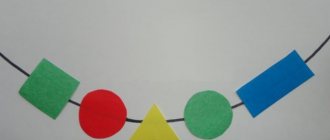The essence of game teaching methods
Game methods have an advantage over other teaching methods, since they are interesting to children and attract attention from the very beginning. Game methods are based on various games that evoke positive emotions that help create a comfortable psychological situation in the learning process. The use of game methods in teaching significantly reduces the cost of nervous energy and volitional efforts.
Are you an expert in this subject area? We invite you to become the author of the Directory Working Conditions
In the process of studying the use of game teaching methods, it was found that these methods help to enhance the mental and motor activity of students. Motor activity has a positive effect on the formation of associative connections that facilitate the process of acquiring knowledge and skills. During play, a child’s perception processes proceed much faster and more accurately.
Game teaching methods have a number of characteristic features:
- The educational material or educational action acquires a conditional plan, which is transferred to the game scenario.
- The game method requires the participation of all participants in the learning process in the game, that is, both students and the teacher participate in the game, which contributes to the direct learning influence on children through comments, instructions, directions, reprimands, tips, etc.
Game methods are very diverse. Their variety depends on the type of game used by the teacher. Regardless of what kind of game is used, the method has two main pedagogical functions:
- Improving and consolidating knowledge. During the game, the child has to use previously acquired knowledge, transform it if necessary, transform it, and learn to operate with his knowledge and skills. All this has a positive impact on expanding and deepening students' knowledge.
- Successful acquisition of new knowledge and skills of varying complexity and content. During the game, most often, in order to assimilate new knowledge, the teacher uses various imaginary situations in an expanded form, using gaming equipment and corresponding game actions and roles. For example, in order to improve and expand knowledge about decorative and applied arts, games “Exhibition”, “Souvenir Shop”, “Journey to the Past”, etc. can be played.
Finished works on a similar topic
Course work Game-based teaching methods 470 ₽ Abstract Game-based teaching methods 230 ₽ Examination Game-based teaching methods 230 ₽
Receive completed work or specialist advice on your educational project Find out the cost
The selection of the type of games for the use of game methods in teaching depends on the age of the students, their psychological and physical development, individual capabilities and needs. Taking into account these criteria will help the teacher select truly effective games that will help enhance the pedagogical impact on students and obtain high learning results.
Thus, the role of game teaching methods in the pedagogical process is quite large. The effectiveness of these methods depends on the professional skills of the teacher, his understanding of the functions of educational games and their importance in the upbringing and teaching of children.
Method is a method of influence or a way of transferring knowledge. Reception - options for using this method. Methods and techniques are divided into gaming, verbal, visual and practical. Let's consider them separately. 1. Game methods and techniques in teaching children: - didactic games, - outdoor games, - fun games, dramatizations. Techniques: a) Bringing in toys, b) Creating game situations (today we will be birds) c) Playing with toys, objects (for example, reading the poem “They dropped the Bear on the floor”, didactic game “Tell me what it sounds like”) d) surprise, emotionality (show “The Bird and the Dog” - the teacher shows a squeaker, makes you want to listen, “Who is singing, look.” A bird flies, circles over the children, sits in his arms, chirps.) e) The suddenness of the appearance, the disappearance of the toy. f) Changing the location of toys (bunny on the table, under the cabinet, above the cabinet). g) Showing objects in different actions (sleeping, walking, eating). h) intriguing settings. 2. Verbal methods and techniques: 1) Reading and telling poems, nursery rhymes, fairy tales. 2) Conversation, conversation. 3) Examination of pictures, staging. Techniques: -Display with naming of toys and objects. The doll Masha walks, walks, bang - fell, fell. Masha, oh-oh, is crying. -Please pronounce, say the word (this is a dress). -Roll call up to 1.5 years (“say-repeat”). - Prompting the right word. -Explanation of the purpose of the item (dishes are what we eat and drink from). -Multiple repetition of a new word in combination with a familiar one (a cat has kittens, a hen has chickens). -Questions. - Finishing the word at the end of the phrase (“Kittens drink (milk)”, “Katya, eat soup (with bread)”). -Repeat the word after the teacher. -Explanation. -Reminder. -Use of artistic words (rhymes, songs, poems, jokes). 3. Practical methods: 1) Exercises (providing assistance). 2) Joint actions of the teacher and the child. 3) Execution of orders. 4. Visual methods and techniques: 1) Showing objects, toys. 2) Observation of natural phenomena and the work of adults. 3) Examination of living objects. 4)Sample display. 5)Use of puppet theater, shadow, tabletop, flannelgraph. 6) Filmstrips. Techniques: -Direct perception of an object, a toy. - Show with a name (this is a rabbit). -Explanation of what the children see (it’s Katya who came; Katya is going for a walk; go, Katya, go; oh, Katya ran and ran away). -Request-suggestion (Andryusha, come on, feed the bird). -Multiple repetition of a word. -Active action of children. -Approaching the object to children. -Assignment for children (go, Vasya, feed the rabbit). -Questions (simple for children under 1.5 years old, difficult for children 2-3 years old). -Artistic word. -Inclusion of objects in children’s activities (“Here I put a cube, another cube on it, another cube, it turned out to be a turret”). -Perform game actions.
The game form of learning is not new in itself. Slogans like: “Teach by playing”, “Use games and game techniques when teaching kids” seem clear and obvious. However, in practice the situation is completely different. Often, educators introduce children's toys and individual play situations into “boring lessons” for preschoolers, believing that they are thereby using play as a form of organizing classes. For example, a character comes and starts explaining something to the children, asking for something. However, neither the character nor the teacher voicing the toy are able to turn an activity into a game on their own. They were, and remain, activities – “lessons”, strictly regulated by adults, where the child is only a passive performer of tasks offered by the teacher. Teaching children to play actually comes down to using game techniques to “play out” educational material when working with them. Such “game moments” in the classroom are fraught with the risk of neither playing nor learning. Why is this happening? One of the reasons for the current practice is teachers’ misunderstanding of the essence of role-playing play and its place in the development of a child’s learning skills.
What does a teacher need to know about the game form of teaching? In the dictionary, the concept of “training” is interpreted as a specially organized process, the purpose of which is the formation of knowledge, skills, abilities in a specific person or group of people. Any training has a real basis. The game is based on an imaginary situation. It consists of a plot and the roles that children take on during the game. In the game, everything happens “as if”, “for fun”, but learning is always serious. During training, we develop in children specific knowledge and skills, for example, about geometric shapes. These concepts are not an imaginary situation. This is a mathematical reality. If, when the play function is undeveloped, children are presented with a mathematical example in the context of an imaginary situation, this will greatly affect the child’s development. Not in the sense that he will not remember the geometric shapes, but in the fact that there will be a shift between different settings. Such training will not have the best effect on the development of imagination, which is the basis for successful learning and development in the future.
A child learns to write with sticks. The job is boring and uninteresting. The teacher invites the child to turn a sheet of paper into a box with cells, and sticks into candies, which must be carefully placed. This activity becomes exciting and interesting. The child learns what is provided by the educational program (development of fine motor skills and hand coordination). This technique can only work if the child has reached the stage of verbalization of an imaginary situation in the development of the game. Mastering the game has several stages. First, the child learns to accept an imaginary situation from an adult. Then he is able not only to accept an imaginary situation, but also to hold it, develop it, and redirect it. At the next stage, the child independently, without the help of an adult, creates an imaginary situation and holds it with the help of words. As D.B. Elkonin noted, by the end of preschool age, children often no longer play so much as talk about the game. In an imaginary situation, the leading role is played by the imagination, which in preschool age becomes a central psychological new formation. Before this period occurs (up to 3 years), imagination is included in other mental processes and functions. Its appearance as an independent mental function means that the task of imagining something becomes understandable and adequate for the child. According to L.S. Vygotsky, to introduce something new “into the very course of our impressions and into the change of these impressions so that as a result a certain new, previously non-existent image arises...”. There are different levels of imagination development in preschool children. Being at the first level, the child depends on the surrounding subject environment. In one case, he “sees” a spoon in the stick, and in another, a thermometer. That is, the meaning of the situation in which the child perceives this object changes. Having the second level of imagination development, children depend little on the subject environment; at the same time, they depend on their personal experience, which they remember. The third level of imagination development is determined by the internal position; the child ceases to be dependent on the subject environment and personal experience. He freely comes up with situations and explains the actions of the characters in his game. Two girls are sitting on a bench and talking enthusiastically:
I will go to the queen’s ball and I will be the most beautiful there!
What will you wear, since you don’t have any new beautiful dresses?
I will take the most beautiful fabric and go to the best dressmaker. Come on, you will be a dressmaker. Sew me the most beautiful dress, like Cinderella’s...
In addition to the verbalization of an imaginary situation, there is another indicator of readiness to accept the game as a form of learning. This is the ability to play games with rules. Games with rules have one very important feature - the preliminary stage, at which the conditions of the game (rules) are negotiated. The child needs to remember them, they need to obey. Rules determine the way of activity. First for play, and then for learning. With the help of rules, the teacher controls the game, the processes of cognitive activity, and the behavior of children. So, a game can be used as a teaching method if it takes place, is mastered and experienced by the child as a valuable activity in its own right. Teachers need to follow all stages of game formation, because the child must consistently master all types of gaming activities. Let us recall these stages. The first is the introductory stage in the development of the game (infancy). The second stage is visual object-play activity (end of the first – beginning of the second year of life). The third stage is plot-display play (end of early childhood). The fourth stage is role-playing play (preschool age). The ability to create an imaginary situation in words and the ability to participate in games with rules are necessary conditions for using games as a form of learning. In preschool pedagogy, the most common methods and techniques are data in a table.
Gaming methods and techniques.
By putting learning into the form of a game, the teacher uses various methods. A teaching method is a system of consistent interconnected ways of working between the teacher and the children being taught, which are aimed at achieving didactic objectives. Teaching methods are not limited to the activities of the teacher alone, but assume that he, using special methods, stimulates and directs the activities of children. Thus, teaching reflects the activities of the teacher and children. Each method consists of techniques, which is its element, component, or separate action in implementation. Game methods in the classification of teaching methods are given a significant place. Their main advantage is that in a game situation, the processes of perception proceed in the child’s mind more quickly and accurately. They transfer the educational action to a conditional plan, which is specified by the corresponding system of rules or scenario. In preschool pedagogy, the most common methods and techniques are the data in the table.
| Game methods | Gaming techniques |
| imaginary situation, didactic game | sudden appearance of objects, toys, the teacher performs various game actions, asking riddles introduction of competition elements, creating a game situation |
One type of game method is a didactic game, in which all actions are regulated by the game task and game rules. Management of the game consists of familiarizing children with its content and rules, as well as monitoring the implementation of the rules. Such a game cannot be considered as a method of replenishing or communicating knowledge. There is an active process of using existing knowledge to ensure its improvement. As a teaching method, didactic games can be used in frontal, group, and individual forms of specially organized training. Lessons consisting of didactic games can be thematic and plot-based. Throughout the entire specially organized training, thematic classes involve the participation of certain characters: Dunno, Mickey Mouse, Parsley, Little Man and others. An interesting form of classes consisting of didactic games are plot-based activities, for example, travel. These lessons may reflect real facts or events. The actions taking place are understandable and interesting to the child. Completing the proposed tasks pleases and surprises children, giving the educational content an unusual, playful character. During such classes, children take an active part in developing the plot, enriching game actions, strive to master the rules and get a result: solve a problem, find out something, learn something. In a story-based lesson, various ways of revealing cognitive material are used in combination with gaming activities: setting tasks, explaining, if necessary, how to solve them, and the joy of solving them.
The reception of the sudden appearance of objects and toys, with its unexpectedness and unusualness, evokes an acute sense of surprise, evokes an emotional response, and is the key to understanding the world around us. This technique is used most often in younger groups. The teacher’s methods of performing various game actions include: selecting pictures, folding, moving, imitation of movements. Game actions may consist of a number of individual actions or elements. They must be accompanied by speech. This technique is used if the teacher is the child’s direct partner in the game. Making riddles allows you to teach children something in an interesting, entertaining way, to tell them about something. The riddle creates the effect of the unknown, the unknown. It helps to establish and realize connections between objects and phenomena. The introduction of competition into classes in older groups prepares children for a correct assessment of their capabilities and achievements, makes the game exciting, entertaining and interesting for the child. The absence of competition in the lesson turns the game into an exercise. Using the technique of creating a game situation in the classroom is aimed at developing search activity. The basis of this technique is game motivation (helping someone solve their problems). For example, the motivating motive for activity may be to help an adult who is “not very skillful” and “absent-minded.” In this case, the game is mischievous and exciting. The choice of game methods and teaching techniques depends, first of all, on the purpose of learning and the content of the lesson, as well as on the age of the children. The teacher should remember that gaming methods and techniques should not turn the lesson into entertainment.
Types of pedagogical impact of game teaching methods
Game teaching methods include a variety of pedagogical games.
Definition 2
Pedagogical games are games that have a specific educational goal and a corresponding pedagogical result.
Pedagogical games are varied and vary depending on:
- didactic content;
- organizational structure;
- age capabilities of children;
- content specifics.
Games used as part of the game teaching method are classified according to the type of pedagogical impact on students:
- Didactic games are aimed at expanding the horizons of students, their cognitive activity, and the formation of specific skills and abilities necessary for the successful implementation of various types of activities.
- Games of educational influence are aimed at developing in students will, independence, various life attitudes (moral, aesthetic, worldview), the ability to cooperate and interact in a team.
- Developmental games are aimed at developing students’ speech, thinking, memory, attention, fantasy, imagination and other various creative skills, as well as developing motivation for learning and acquiring new knowledge.
- Games that have a socializing effect are aimed at familiarizing students with the norms and rules of behavior within modern society, developing the ability to adapt to new conditions, effectively interact and communicate with others, and master the skills of self-regulation and self-control.
Note 1
Thus, game teaching methods are very diverse and are aimed at the comprehensive education and development of students through various types of pedagogical influence.
What are these processes?
Game-based learning (or game-based learning)
This is training that uses game elements to teach a specific skill or achieve a specific outcome. To do this, educational materials are processed into a game format and made more interesting.
Gamification
Gamification is the application of game mechanics in a non-game context to encourage desired behavior and achieve learning outcomes.
Think points, badges, leaderboards and incentives. The main difference between the two is the integration of game mechanics with educational content. Game-based learning completely combines these two components, so that play is learning. On the other hand, gamification uses game elements as rewards for completing training modules.
Application of game-based learning
In a gamified learning environment, users learn new concepts and practice skills in a safe environment. Their progress is directly dependent on their understanding of the subject being studied.
Examples of game-based learning:
- Investment trainers
- Programs for learning foreign languages (Duolingo, Busuu)
Game-based learning has a significant impact on employee retention and engagement. Users become more interested in the subject, making learning fun. And when engagement levels increase, so does information retention. An MIT study found that training using game-based learning technologies increased retention by more than 300% immediately after testing.
Game-based learning is also good for teaching complex concepts. Because learning is both fun and challenging, employees stay engaged longer. Employees can also practice applying new skills and knowledge without real-world consequences. They receive feedback that helps them hone new skills before they are tried out in the real world.
But this format also has a drawback. It requires the creation of new learning modules, and creating a game-based learning environment can be costly and time-consuming. This can be a major hurdle for some companies.



